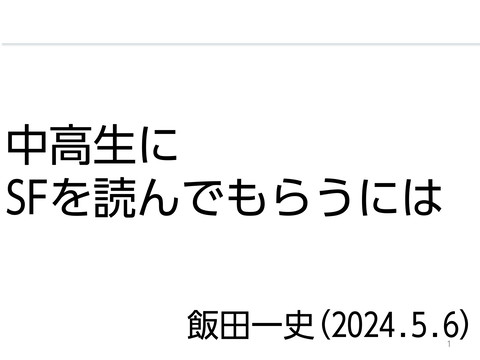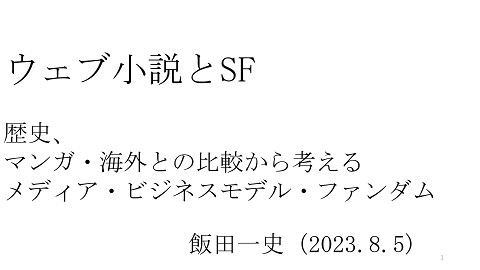日本における マンガの消費スタイルの変化 일본에서 만화 소비 스타일의 변화 Changes in manga consumption styles in Japan
406 Views
September 29, 24
スライド概要
B-COM Webtoon Conference(2024.10.5)
Topic:The Transition of Comics and Webtoon Literacy in the Digital Media Era
日本で漫画の読み方はどのように変化しているのか(飯田一史)
■ 1970s'-2000s':雑誌とコミックス単行本の一体型流通
日本の出版流通は雑誌と書籍の一体型流通を特徴とする。日本では週刊や月刊で刊行される雑誌も、定期刊行物ではない
書籍も、同じ小売書店で扱われている。週刊・月刊の漫画専門誌は1950年代に登場する。漫画雑誌に連載され、ある程
度の分量が溜まると連載中からコミックス単行本としても順次刊行されるしくみは1970年代に一般化した(日本では韓国
の貸本漫画、あるいはバンドデシネのような描き下ろしの漫画作品は少ない)。ただし70年代までは漫画雑誌で連載形式
で読む方が主流だった。80年代以降にコミックス単行本市場も大幅に成長する。その理由は複合的だが、ひとつ例に挙げ
るなら、たとえば1970年代にTV放映され、のちに劇場用映画となった『宇宙戦艦ヤマト』『機動戦士ガンダム』をきっかけに
したアニメブームの存在がある。これによってTVアニメの制作本数が増え、アニメの原作となる漫画の数が増えた。TV
アニメから作品を知り、原作漫画を読んだ読者は、漫画雑誌よりもまずコミックス単行本を購入するケースが珍しくなか
った。そして漫画読者は、購買スタイルによって雑誌連載で読む「雑誌派(本誌派、連載派)、雑誌は買わずコミックスだ
け買う「単行本派」に分化していく。
インターネットの普及など複合的な要因によって1990年代中盤をピークに漫画雑誌の部数は減少し始める。2005年には
漫画雑誌とコミックスの売上規模が逆転し、コミックス単行本が漫画消費の中心になる。
2000年代の漫画市場では、店内で読書する、漫画房+PC房と同様の「漫画喫茶」(ネットカフェ)や、貸与店と同様に店外貸
出する(ただし新刊書店と兼業)「漫画レンタル」、発売間もないコミックスも流通する古本屋チェーン「ブックオフ」も流行し
た。ただしこれらの業態は2010年代に入り、スマートフォン向けのマンガアプリが登場し、人気を博すると衰えていく。
■2 010's-2020's:マンガアプリ、ウェブマンガ誌の台頭
マンガアプリには各社の電子書籍、ウェブトゥーンを取り扱うストア/プラットフォームと、出版社が新作漫画の開発・
育成を主目的としたサービスの二系統に分かれる。前者は「書店」、後者は「漫画雑誌」と同様の機能を持つ。前者の代表が
カカオピッコマのピッコマであり、さまざまな出版社、CP社の作品を取り扱い、マンガアプリとして日本最大級の売上
を誇る。後者の代表が集英社の少年ジャンプ+であり、アプリオリジナルの連載作品『SPY×FAMILY』『怪獣8号』などが生ま
れた。2020年代に入ると、マンガアプリよりも運用コストが安く、ソーシャルメディアへの共有がしやすいウェブマン
ガ誌に改めて注目が集まり、講談社のヤンマガWebなど、出版社発のメディアが伸び基調にある。
マンガアプリでは、2014年に小学館マンガワンが成功させて以降、「話売り」(連載漫画の単話形式での販売)が一般化す
る。また、「ライフ/チケット制」と呼ばれる1枚で1話読める無料チケットが1日2回、1回4枚配布するしくみか、ピッコマ
がカカオページから持ち込んだ「待てば無料」と「話売り」を組み合わせた。連載の最新話は毎週1話ずつ更新されるという
従来同様の頻度だが、読者は無料でも最低1日1話読めるようになった。漫画雑誌衰退後に崩壊していた「漫画を習慣的に
読む」サイクルを再構築した。
日本ではデジタルにリプレイスしながらも、新人・新作を育成する「雑誌」(マンガアプリ、ウェブマンガ誌)と、各社の雑
誌から育った作品を集めた「書店」(ピッコマ、Amazonなど)が分業するかたちで共存している。また、連載最新話を単話
形式で課金して読む「連載派」も、コミックスにまとまってから巻単位で購入する「単行本派」も、また、紙の本も電子書籍
も読者が併存している。
■ 市場規模が史上最大になる一方、小中高生の漫画読書率は低下
2020年代の日本の漫画市場は史上最大規模となった。だが小中高生の漫画読書率は低下し、韓国の子どもより読んでい
ない。日本の漫画市場は大人向けに偏っている。若年層向けの充実が課題である。
ライター。単著『「若者の読書離れ」というウソ』『ウェブ小説30年史』『いま、子どもの本が売れる理由』『マンガ雑誌は死んだ。で、どうなるの?』『ウェブ小説の衝撃』ほか。
関連スライド
各ページのテキスト
日本における マンガの消費スタイルの変化 일본에서 만화 소비 스타일의 변화 Changes in manga consumption styles in Japan 飯田一史Iida Ichishi(2024.10.5) 1
Characteristics of Japanese publishing: Integrated distribution of magazines and books For a long time, manga reading has been centered around magazines. Bookstores sell both magazines and books. Magazines have not typically delivered by subscription Since the 60s. 촬영 : 이이다 카즈후미
Magazine functions:①집객②선전③육성 ①retention Visit bookstores on each magazine release date. Customers who visit on magazine release days also buy books. ②promotion Promote new series and comic book releases in the magazine. 신인상 신연재 만화책 잡지 ③incubation Discover new talent. Develop and nurture new works. 3
80s-90s:애니메이션 수UP → 만화 수요UP Trends in the Number of New TV Anime Broadcasts Anime Boom (우주전함 야마토,건담) 140 120 100 Changes in the Proportions of Source Works for TV Anime 127 103 1960s' 81 77 74 69 80 6059 60 464444 40 3940 40 30 24 25 21 1816191816161920 1412 20 8 49 37 39 32 Original Anime Manga Novel Merch unknown 45 1970s' 1980s' 1990s' 35 23 3 0 63 66 69 72 75 78 81 84 87 90 93 96 99 2000s' Game Others 42% 50% 52% 27% 35% 36% 30% 37% 26% 33% 1% 4% 11% 0%3% 4%0% 0% 2% 0% 19% 17% 2% 6% 3% 7% 2% 8% 12% 8% 2% 13% 6% 谷本菜穂、増田のぞみ、東園子、猪俣紀子、山中千恵「日本におけるテレビアニメ放映データの分 析-リストの作成とその概要-」甲南女子大学研究紀要. 文学・文化編 (50), 33-40, 2014を元に作成 Based on the work by Naho Tanimoto, Nozomi Masuda, Sonoko Higashi, Noriko Inomata, and Chie Yamanaka titled ‘Analysis of TV Anime Broadcast Data in Japan: Creation of a List and Its Overview,’ Konan Women‘s University Bulletin. Literature and Culture Edition (50), 33-40, 2014
잡지에서 연재 최신화를 읽는 '잡지파'(본지파)와 잡지는 읽지 않고 단행본으로 나올 때까지 기다려 읽는 '단행본파'로 나뉘었다 2 types of Manga readers ①magazine readers (serialization readers) ②comic book readers
00s:The decline of magazines size of the Japanese manga market Unit: 100 million yen Source: 出版科学研究所 만화책>잡지 7000 6000 5000 4000 3000 2000 1000 0 1995 1996 1997 1998 1999 2000 2001 2002 2003 2004 2005 2006 2007 2008 2009 2010 2011 2012 2013 comic book manga magazine The habit of reading manga regularly has broken.
00s:thrives on Rentals & Used Books ①Rentals (non-possessive consumption) Manga cafes (Internet cafes); reading in the store. Same as 만화방+PC방 Manga rental; https://www.kaikatsu.jp/guide/ Similar to대여점. These also operate as a new bookstore. ②Used Books/Discounted sales Book-Off; The Used book store chain sells relatively new comics. https://x.com/8210nTsutaya/status/1014346534849216512/photo/1 https://www.bookoff.co.jp/shop/shop20033.html These types of businesses have declined since the 10s.
10s:The rise of MangaApps & e-books 사상 최대 size of the Japanese manga market Unit:100 million yen Source:出版科学研究所 8000 만화 앱 등장 7000 6000 5000 4000 3000 2000 1000 0 1995 1996 1997 1998 1999 2000 2001 2002 comic book 2003 2004 2005 2006 2007 2008 2009 2010 2011 2012 2013 manga magazine 2014 2015 2016 2017 2018 2019 2020 2021 2022 digital comic 2023
Manga apps have made daily use routine. Print Manga Comic Magazine Book Digital Manga Apps, E-book Web Magazine Example Sales Methods Single work, Individual works,Single work, multiple multiple sold one chapter chapters chapters at a time included included Bundle Update Weekly /Viewing or Frequency Monthly Price Every 2-4 Months Fixed Serialized Weekly. Every 2-4 Read daily for Months free by waiting Discounted 9
20s:A Division between ①publisher apps/sites and ②e-book stores 잡지형 서점형 ①Fostering new talent and new works Supporting until they become popular works. Distributing the latest episodes first ②Selling many company's works. Effectively selling popular works 10
Apps & web have replaced magazines, but print and digital coexist. size of the Japanese manga market first medium 8000 7000 6000 5000 4000 3000 2000 1000 0 2014 2015 2016 2017 2018 2019 2020 2021 2022 2023 digital comic manga magazine comic book print comic book e-book Single -chapter sale
The Product Life Cycle of Manga-Based IP Introduction Revenue Generated By the IP Growth Maturity Decline production cost years Media Years Revenue Cost Magazine, Manga Apps Small Pricey Comic book, Anime,Drama, E-book GAME,theater 0-3 3-5 Moderate Huge Inexpensive Expensive 2nd,3rd season 4-11 Substantial Costly Readers are flowing into manga from various media.
But, Japanese Kids and youth read less manga. reading rate Elementary Middle High Adult Of Manga Schoolers Schoolers Schoolers s 1985 88% 85% 77% 1995 85% 79% 65% 17% 68% 60% 49% 2023Print 2023Ditital 15% 35% 49% - 出典:全国学校図書館協議会「学校読書調査」1986年版,1996年版、ベネッセ教育総合研究所「子どもの読書行動の実態 調査結果からわかること」2023年.Based on Japan School Library Association’s'School Reading Survey' editions from 1986 and 1996, and Benesse Educational Research Institute's 'Actual Reading Behavior of Children: Findings from Survey Results' 2023. 한국 초등학생 중학생 고교생 성인 2019만화책 74% 93% 59% 22% 2019웹툰 70% 87% 84% 20% 출처 : 문화체육관광부 '국민독서실태조사'2020. 13
Korean webtoons are 3-tiered 3rd:Rom-Com,HumanDrama suited for live-action 2nd:Romance Fantasy,Wuxia,Action 1st:Gags,Comedy,Essaytoon 3rd:Adap Works that are tation widely read for free(1st), heavily monetized(2nd), and suited for adaptation(3rd) are distinct. 2nd:Paid 복학왕 1st:AD There are content and business models enjoyable for kids and youth without payment. 14
In Japan,Few Digital Comics For Kids & Teens 8000 It’s skewed toward adults with high spending. 7000 6000 3000 Average books read per month is increasing, but the manga readership is declining. 2000 Source: SLA(Japan School Library Association) 5000 4000 1000 13.2 12.712.6 14 0 2023 digital comic manga magazine comic book ES 12 11.4 9.79.4 10 8 7.5 7.77.7 8 5.6 6 4.7 4.34.1 4.1 4.14 4 3.83.5 2 0 2.5 10.5 109.9 10.1 8.6 9.8 MS 4.2 4.2 3.93.7 3.7 4.13.9 4 3.4 3.3 2.8 2.92.8 2.5 2.3 2.4 2.5 2.3 2.12.1 2 2 1.9 1.91.82.11.91.8 1.92.12.11.92.1 1.9 2 2.1 2.1 2 1.81.91.61.81.7 1.7 1.71.7 1.5 3.7 4 3.13.4 3 3.2 2.9 2.5 2.5 2.3 2.3 2.3 2.2 2.2 2.2 2.12.3 2.2 1.9 7.6 7.4 7.4 7.1 6.8 6.5 6.56.46.7 6.46.36.8 6.3 6.16.2 6 5.8 5.8 5.6 5.6 5.4 5.3 5 4.7 4.6 4.54.3 4.3 4.5 11.4 11.4 11.2 11.111.3 5.3 5.5 4.7 4.7 4.5 4.2 4.3 HS 2.42.2 2.12.1 2 1.9 1.81.81.91.6 1.81.6 1.6 1.71.91.81.61.71.6 1.61.5 1.4 1.51.31.41.71.5 1.51.41.31.31.3 1.5 1.5 1.51.41.51.31.41.61.6 1.4 1.3 1.31.31.51.41.31.31.31.21.1 1.31.31.11.51.3 1.21.2 1 1 1955 1958 1960 1963 1965 1967 1969 1971 1973 1975 1977 1979 1981 1983 1985 1987 1989 1991 1993 1995 1997 1999 2001 2003 2005 2007 2009 2011 2013 2015 2017 2019 2022 A major issue for the future of Manga industry. 15





